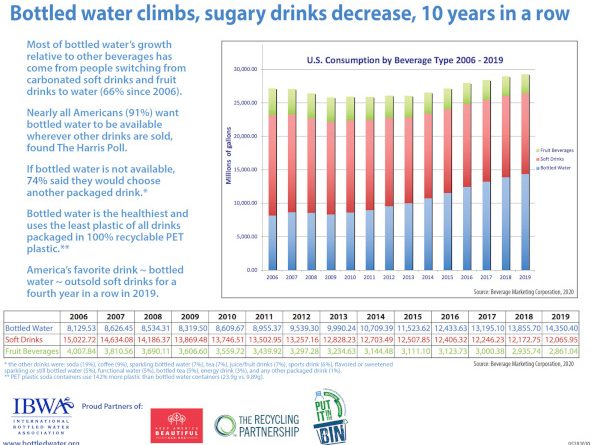Bottled water consumption grows, sugary drinks decrease, 10 years in a row
Bottled water has once again reaffirmed its position as America’s favorite drink, outselling all other packaged beverages in 2019, new data from the Beverage Marketing Corporation (BMC) shows.
Consumers are increasingly choosing bottled water instead of less healthy packaged drinks. The BMC data detail how, since 2010, bottled water has steadily increased in sales volume each year, while consumption of carbonated soft drinks has declined. Bottled water outsold soda for the first time in 2016 and has done so each year. Americans consumed 14.4 billion gallons of bottled water in 2019, up 3.6 percent from 2018. Bottled water’s retail dollar sales also grew in 2019, up 5.2 percent reaching $34.6 billion. And per capita consumption rose 3.1 percent to 43.7 gallons, BMC data show.
For over a decade, the majority of the growth in bottled water consumption relative to other beverages has come from people switching to bottled water from other less-healthy packaged drinks (66 percent since 2006). And nine out of ten Americans (91 percent) expect bottled water to be available wherever other drinks are sold, according to a survey conducted on behalf of the International Bottled Water Association (IBWA) by The Harris Poll. This healthy consumption shift from sugary drinks to bottled water could also work in reverse. If bottled water is not available, 74 percent of people say that they will turn to other packaged drinks, not tap water, The Harris Poll found.
“People are choosing to drink fewer calories and making that healthy choice has the added benefit of helping the environment. Not only are bottled water containers 100 percent recyclable (including the caps) but they also contain much less plastic than soda and other packaged beverages,” says Jill Culora, IBWA’s vice president of communications. Soda containers, on average, use 142 percent more PET plastic than bottled water containers (23.9 grams vs. 9.89 grams for 16.9-ounce containers). Soft drinks and other sugary beverages need thicker plastic containers due to their carbonation and/or bottling processes.
Even with continuing growth and increased consumption, bottled water still has the smallest water and energy use footprint of any packaged beverage. On average, only 1.39 liters of water and 0.21 mega joules of energy are used to produce 1 liter of finished bottled water (this includes the 1 liter of water consumed).
A recent report from the American Chemistry Council (ACC), conducted by Franklin Associates, examined the overall impact of plastics on the environment, compared to other materials. The study looked at energy demand, water consumption, solid waste, global warming potential, eutrophication potential, smog formation potential, and ozone depletion potential. The ACC report concluded that, when comparing materials throughout the entire life cycle of a package, plastics leave a much smaller environmental footprint than alternatives, such as glass, aluminum cans, and paperboard cartons. Perhaps the most significant finding from the ACC report is that alternatives to plastic beverage containers would produce about 60 percent more greenhouse gas emissions—a major contributor to climate change.

